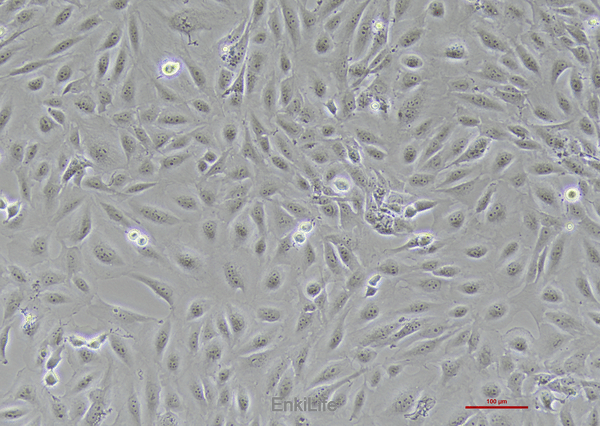人正常肺上皮細(xì)胞BEAS-2B
一. 細(xì)胞來源
1.建系背景:BEAS-2B細(xì)胞系于1988年由Curtis C. Harris團(tuán)隊(duì)建立����,源自非癌個體的人正常支氣管上皮細(xì)胞,通過腺病毒12-SV40雜交病毒轉(zhuǎn)染實(shí)現(xiàn)永生化�����,保留非致瘤性特征 [1][2][3]����。
2.爭議點(diǎn):近年研究發(fā)現(xiàn)其可能兼具間充質(zhì)干細(xì)胞(MSC)特性,挑戰(zhàn)了傳統(tǒng)上皮細(xì)胞起源認(rèn)知[1]���。
 ?
?
二. 生物學(xué)特性
1.形態(tài)與分子標(biāo)志物:
- 典型上皮形態(tài)��,表達(dá)角蛋白CK8/CK18和E-鈣黏蛋白(E-Cadherin) [3][15]�����。同時表達(dá)MSC表面標(biāo)志物(如CD73����、CD90、CD105)�����,并具多向分化潛能(成骨��、成脂)[1]���。
2.功能特性:
- 免疫調(diào)節(jié):抑制T淋巴細(xì)胞增殖及Th1分化,誘導(dǎo)IDO1表達(dá) [1]���。
- 代謝特征:糖酵解和氧消耗受培養(yǎng)條件顯著影響(如胎牛血清FBS)[4]��。
3.爭議特性:
- 缺乏分化能力(如氣液界面培養(yǎng)中無法形成緊密連接或纖毛/杯狀細(xì)胞) [15]��,但部分研究支持其MSC特性非上皮-間質(zhì)轉(zhuǎn)化(EMT)所致[1]�����。
三. 培養(yǎng)與儲存
1.培養(yǎng)條件:基礎(chǔ)培養(yǎng)基為DMEM/F12�,需添加生長因子(如EGF、胰島素)��。
2.關(guān)鍵影響因素:胎牛血清(FBS)顯著改變細(xì)胞代謝和砷毒性敏感性���,需謹(jǐn)慎選擇培養(yǎng)體系 [4]���。
3.儲存:液氮凍存(含10% DMSO+90% FBS),復(fù)蘇存活率>90%���。
四. 研究應(yīng)用領(lǐng)域
1.呼吸毒理學(xué):
- 評估環(huán)境污染物(如砷�����、石棉�����、PM2.5)的細(xì)胞毒性及致癌機(jī)制[5][6][7]�����。
2.肺癌研究:
- 作為非小細(xì)胞肺癌(NSCLC)的對照細(xì)胞���,研究致癌基因(如circ-0067934����、miR-21)的表達(dá)差異[8][9]�。
- 慢性砷暴露模型顯示致癌信號通路(如STAT3-Akt)激活[10][16]。
3.免疫與感染:
- 高基礎(chǔ)干擾素刺激基因(ISG)表達(dá)賦予甲型流感病毒抗性[11]���。
- 真菌感染應(yīng)答機(jī)制研究 [12]���。
五. 近年研究進(jìn)展(2020–2025)
1.MSC特性證實(shí):2020年研究明確其表達(dá)MSC標(biāo)志物,具免疫抑制功能�,為肺部纖維化疾病研究提供新模型 [1]。
2.代謝模型優(yōu)化:計算模型整合氧/葡萄糖代謝參數(shù)�����,提升體外毒性預(yù)測準(zhǔn)確性 [13]�����。
3.致癌機(jī)制深化:
- 砷暴露通過NFAT通路誘導(dǎo)COX-2表達(dá)�,抑制凋亡 [14]。
- p53缺失增強(qiáng)惡性轉(zhuǎn)化能力(軟瓊脂克隆����、裸鼠致瘤) [10]。
六. 局限性與克服方法
1.局限性:
- 表型不穩(wěn)定性:FBS誘導(dǎo)代謝和基因表達(dá)偏移�,影響實(shí)驗(yàn)可重復(fù)性 [4]。
- 分化缺陷:無法模擬氣道上皮屏障功能����,限制呼吸生理研究 [15]。
2.克服策略:
- 優(yōu)化無血清培養(yǎng)體系��,減少批次差異 [4]�����。
- 聯(lián)合原代細(xì)胞或類器官模型驗(yàn)證關(guān)鍵結(jié)論 [13����。
七. 總結(jié)與展望
BEAS-2B細(xì)胞因其易獲取、永生化特性���,成為呼吸疾病研究的核心工具����。未來研究方向可:
1.深入解析其上皮/MSC雙重特性的分子基礎(chǔ);
2.開發(fā)標(biāo)準(zhǔn)化培養(yǎng)方案以提升數(shù)據(jù)可比性��;
3.整合多組學(xué)技術(shù)探索其在精準(zhǔn)毒理學(xué)中的應(yīng)用�。

參考文獻(xiàn)
1. Human Lung Epithelial BEAS-2B Cells Exhibit Characteristics of Mesenchymal Stem Cells. Han X, et al. PLoS One. 2020;15(1):e0227175. [PMID: 31940397]
2. Transformation of human bronchial epithelial cells by infection with SV40 or adenovirus-12 SV40 hybrid virus. Reddel RR, et al. Cancer Res. 1988;48(7):1904-1903. [PMID: 2832044]
3. Human cell-based in vitro systems to assess respiratory toxicity: a case study using silanes. Sharma M, et al. Toxicol Sci. 2023 Sep 28;195(2):213-230. [PMID: 37498623]
4. Culture conditions profoundly impact phenotype in BEAS-2B, a human pulmonary epithelial model. Zhao F, et al. J Appl Toxicol. 2015 Aug;35(8):945-51. Epub 2014 Dec 19. [PMID: 25524072]
5. Genome-wide analysis of BEAS-2B cells exposed to trivalent arsenicals. Chilakapati J, et al. Toxicol Appl Pharmacol. 2010;247(1):23-29. [PMID: 205620211]
6. 張敏.溫石棉和石棉替代品致BEAS-2B和Met-5?A細(xì)胞的損傷作用[D].浙江大學(xué),2013.
7. 武博.鴨舍環(huán)境微生物氣溶膠監(jiān)?測及其對小鼠肺損傷與BEAS-2B細(xì)胞毒理機(jī)制的研究[D].山東農(nóng)業(yè)大學(xué),2020.
8. Overexpression of circ-0067934 is associated with increased cellular proliferation and the prognosis of non-small cell lung cancer. Zou Q, et al. Oncol Lett. 2018 Nov;16(5):5551-5556. [PMID: 30344708]
9. MicroRNA-21 (miR-21) regulates cellular proliferation, invasion, migration, and apoptosis by targeting PTEN, RECK and Bcl-2 in lung squamous carcinoma, Gejiu City, China. Xu LF, et al. PLoS One. 2014 Aug 1;9(8):e103698. [PMID: 25084400]
10. Human bronchial epithelial BEAS-2B cells, an appropriate in vitro model to study heavy metals induced carcinogenesis. Park YH, et al. Toxicol Appl Pharmacol. 2015 Sep 15;287(3):240-5. [PMID: 26091798]
11. High basal expression of interferon-stimulated genes in human bronchial epithelial (BEAS-2B) cells contributes to influenza A virus resistance. Seng LG, et al. PLoS One. 2014 Oct 14;9(10):e109023. [PMID: 25313647]
12. In silico model development and optimization of in vitro lung cell population growth. Mostofinejad A, et al. PLoS One. 2024 May 15;19(5):e0300902. [PMID: 38748626]
13. Cyclooxygenase-2 induction by arsenite is through a nuclear factor of activated T-cell-dependent pathway and plays an antiapoptotic role in Beas-2B cells. Ding J, et al. J Biol Chem. 2006 Aug 25;281(34):24405-13. [PMID: 16809336]
14. Evaluation of Differentiated Human Bronchial Epithelial Cell Culture Systems for Asthma Research. Stewart CE, et al. J Allergy. 2012;2012:943984. [PMID: 22287916]
15. Chronic occupational exposure to arsenic induces carcinogenic gene signaling networks and neoplastic transformation in human lung epithelial cells. Stueckle TA, et al. Toxicol Appl Pharmacol. 2012 Jun 1;261(2):204-16. [PMID: 22521957]